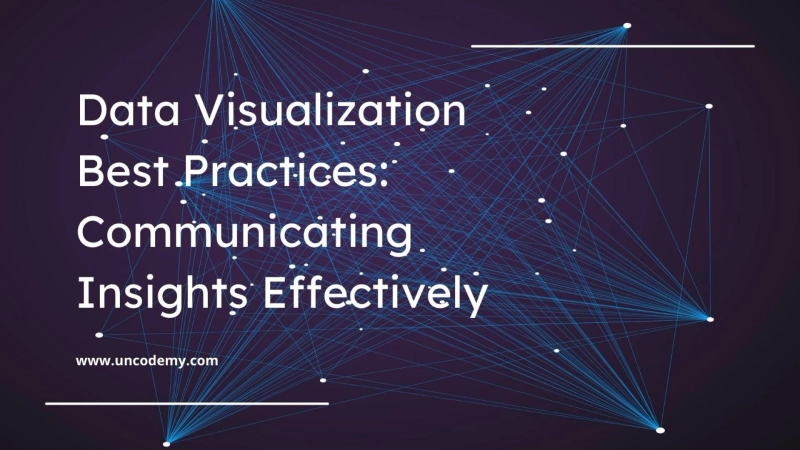Introduction
Data visualization is the graphical representation of data and information. It enables analysts, stakeholders, and decision-makers to understand complex datasets by presenting them in a visual format. Effective data visualization enhances comprehension, aids in identifying patterns, and uncovers insights that might otherwise remain hidden.
Importance of Data Visualization
Data visualization plays a pivotal role in transforming raw data into actionable insights. Here are a few reasons why it is essential:
Enhanced understanding: Visual representations help people grasp information quickly and comprehend complex relationships within the data.
Improved decision-making: Clear and intuitive visualizations enable decision-makers to make informed choices based on data-driven insights.
Effective storytelling: Visualizations have the power to tell compelling stories by presenting data in a narrative format.
Identification of trends and patterns: Visualization tools facilitate the identification of trends, patterns, and correlations that may not be evident in raw data.
Understanding the Audience
Before creating visualizations, it is crucial to understand the target audience. Consider their background, level of familiarity with data, and the specific insights they seek. This understanding will influence the design choices, level of detail, and complexity of the visualizations.
Choosing the Right Visualization Types
Different types of data require different visualization techniques. Some common visualization types include:
Bar charts: Suitable for comparing categorical data.
Line charts: Ideal for showing trends and changes over time.
Scatter plots: Effective for displaying relationships and correlations between variables.
Heatmaps: Useful for visualizing large datasets and identifying patterns.
Tree maps: Effective for displaying hierarchical data structures.
Choosing the appropriate visualization type ensures that the data is represented accurately and meaningfully.
Simplifying Complexity
Complex datasets can overwhelm audiences, leading to confusion and misinterpretation. To communicate insights effectively, it is essential to simplify the complexity without losing the essence of the data. This can be achieved by:
Filtering and summarizing: Focus on the most relevant data points and summarize the information to highlight key findings.
Using concise labels and titles: Ensure that labels and titles are clear, concise, and unambiguous.
Avoiding clutter: Remove unnecessary elements and reduce visual noise to maintain clarity.
Effective Use of Colors
Colors can enhance the visual appeal of data visualizations, but they must be used thoughtfully. Consider the following guidelines:
Consistency: Use consistent color schemes throughout the visualizations to maintain coherence.
Contrast: Ensure sufficient contrast between different elements to aid readability.
Color symbolism: Be mindful of cultural associations and avoid using colors that may convey unintended meanings.
Color blindness considerations: Use color combinations that are accessible to individuals with color vision deficiencies.
Storytelling through Data
Data visualizations can be powerful storytelling tools. By organizing data in a logical sequence and guiding the audience through a narrative, insights can be effectively communicated. Consider the following storytelling elements:
Beginning: Set the context and introduce the problem or question the data aims to address.
Middle: Present the data, highlight key patterns, and explain the insights derived from it.
End: Summarize the findings, draw conclusions, and suggest actionable steps based on the insights.
Interactivity and User Experience
Interactive data visualizations provide an immersive experience and allow users to explore the data based on their specific interests. Incorporate features such as tooltips, filters, and drill-down options to enhance user engagement and understanding.
Mobile-Friendly Visualizations
In today's mobile-centric world, it is essential to ensure that data visualizations are mobile-friendly. Optimize visualizations for smaller screens, prioritize essential information, and consider touch-based interactions for a seamless user experience.
Testing and Iteration
Before finalizing data visualizations, conduct thorough testing and gather feedback from the target audience. Iteratively refine the visualizations based on the feedback received, ensuring that they effectively communicate the desired insights.
Data Visualization Tools
Numerous data visualization tools are available that simplify the creation of visually appealing and interactive visualizations. Some popular tools include:
Tableau
Power BI
D3.js
Plotly
Google Data Studio
These tools offer a wide range of features and capabilities to create stunning visualizations.
Enhancing Skills in Data Visualization
For individuals looking to enhance their skills in data visualization, enrolling in a data science certification course in Bhubaneswar can be highly beneficial. These courses provide comprehensive training on various data visualization techniques, tools, and best practices, empowering participants to communicate insights effectively.
Exploring Advanced Data Visualization Techniques
For professionals seeking in-depth knowledge of advanced data visualization techniques, data science training programs offer specialized modules. These programs delve into advanced visualization concepts, storytelling through data, and interactive visualization development, equipping participants with the expertise to excel in this field.
Conclusion
Effective data visualization is an invaluable asset in today's data-driven landscape. By following best practices, understanding the audience, and leveraging suitable tools, professionals can communicate insights effectively, leading to informed decision-making and improved outcomes.
FAQs (Frequently Asked Questions)
What is data visualization?
Data visualization is the graphical representation of data and information, enabling users to understand complex datasets visually.
How does data visualization help in decision-making?
Clear and intuitive data visualizations provide decision-makers with actionable insights based on data, leading to informed choices.
What are some popular data visualization tools?
Popular data visualization tools include Tableau, Power BI, D3.js, Plotly, and Google Data Studio.
What are the benefits of interactive data visualizations?
Interactive data visualizations engage users and allow them to explore the data based on their interests, enhancing their understanding of insights.
How can I enhance my data visualization skills?
Enrolling in a data science course or participating in data science training programs can help enhance data visualization skills effectively.



